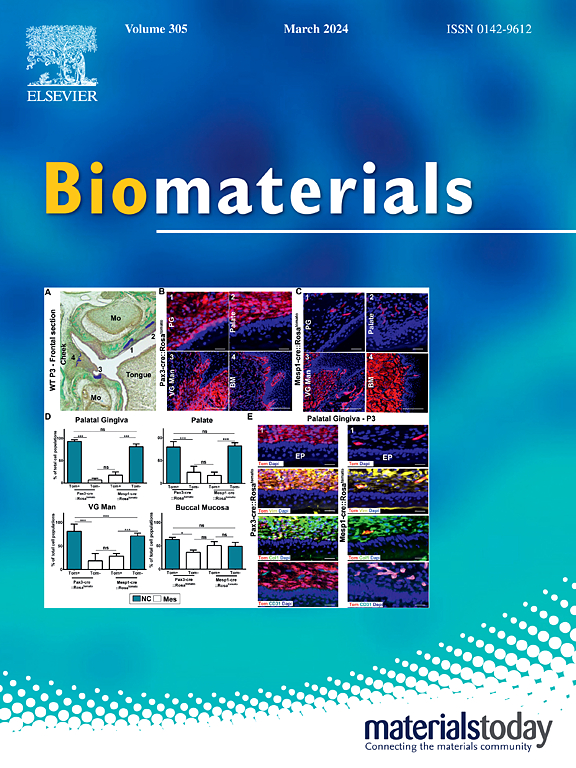Engineered exosomes for targeted microRNA delivery to reverse liver fibrosis
IF 12.9
1区 医学
Q1 ENGINEERING, BIOMEDICAL
引用次数: 0
Abstract
Despite the widespread use of nucleic acid drugs in liver fibrosis treatment, their therapeutic efficacy remains limited due to challenges in penetrating extracellular matrix (ECM) and effectively targeting activated hepatic stellate cells (aHSCs). Exosomes (Exos) have emerged as promising drug carriers; however, their clinical application is hindered by low yield, limited drug-loading capacity, and suboptimal delivery efficiency. To overcome these challenges, we developed a nanosecond pulsed microfluidic system (T-nsPMs) for the high-throughput production of engineered Exos. These Exos were co-modified with a 5HT1D antibody and CD47 protein (TCMExos) to construct a nanoscale drug delivery system for the targeted delivery of microRNA-29b (miR-29b). TCMExos effectively penetrated the ECM, evaded macrophage phagocytosis, and targeted aHSCs, enabling the precise release of miR-29b at the site of fibrosis. This led to the inhibition of hepatic stellate cells activation, as demonstrated by the significant downregulation of α-SMA, COL1A1, TIMP-1, and phosphorylated SMAD2 proteins. Moreover, TCMExos markedly reduced collagen fibers deposition, showing excellent antifibrotic efficacy. Mechanistic studies revealed that TCMExos exert their antifibrotic efficacy by suppressing the TGF-β/SMAD signaling pathway. In conclusion, this work presents a new strategy for liver fibrosis treatment, offering an efficient and targeted approach to overcome current therapeutic limitations.

靶向microRNA递送的工程外泌体逆转肝纤维化
尽管核酸药物广泛应用于肝纤维化治疗,但由于其在穿透细胞外基质(ECM)和有效靶向活化的肝星状细胞(aHSCs)方面存在挑战,其治疗效果仍然有限。外泌体(Exos)已成为有前途的药物载体;然而,它们的临床应用受到产率低、载药能力有限和递送效率不理想的阻碍。为了克服这些挑战,我们开发了一种纳秒脉冲微流体系统(T-nsPMs),用于工程Exos的高通量生产。这些Exos与5HT1D抗体和CD47蛋白(TCMExos)共修饰,构建靶向递送microRNA-29b (miR-29b)的纳米级药物递送系统。TCMExos有效穿透ECM,避开巨噬细胞吞噬,靶向aHSCs,使miR-29b在纤维化部位精确释放。这导致肝星状细胞活化受到抑制,α-SMA、COL1A1、TIMP-1和磷酸化的SMAD2蛋白显著下调。此外,TCMExos显著减少胶原纤维沉积,显示出良好的抗纤维化效果。机制研究表明,TCMExos通过抑制TGF-β/SMAD信号通路发挥抗纤维化作用。总之,这项工作提出了一种新的肝纤维化治疗策略,提供了一种有效的、有针对性的方法来克服当前的治疗局限性。
本文章由计算机程序翻译,如有差异,请以英文原文为准。
求助全文
约1分钟内获得全文
求助全文
来源期刊

Biomaterials
工程技术-材料科学:生物材料
CiteScore
26.00
自引率
2.90%
发文量
565
审稿时长
46 days
期刊介绍:
Biomaterials is an international journal covering the science and clinical application of biomaterials. A biomaterial is now defined as a substance that has been engineered to take a form which, alone or as part of a complex system, is used to direct, by control of interactions with components of living systems, the course of any therapeutic or diagnostic procedure. It is the aim of the journal to provide a peer-reviewed forum for the publication of original papers and authoritative review and opinion papers dealing with the most important issues facing the use of biomaterials in clinical practice. The scope of the journal covers the wide range of physical, biological and chemical sciences that underpin the design of biomaterials and the clinical disciplines in which they are used. These sciences include polymer synthesis and characterization, drug and gene vector design, the biology of the host response, immunology and toxicology and self assembly at the nanoscale. Clinical applications include the therapies of medical technology and regenerative medicine in all clinical disciplines, and diagnostic systems that reply on innovative contrast and sensing agents. The journal is relevant to areas such as cancer diagnosis and therapy, implantable devices, drug delivery systems, gene vectors, bionanotechnology and tissue engineering.
 求助内容:
求助内容: 应助结果提醒方式:
应助结果提醒方式:


